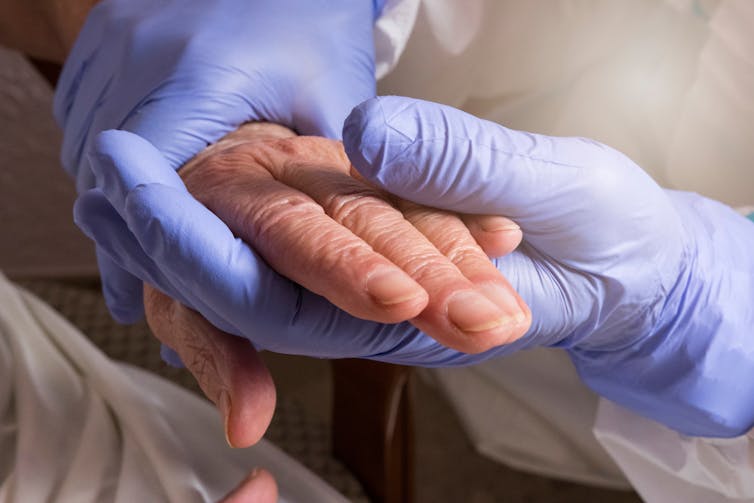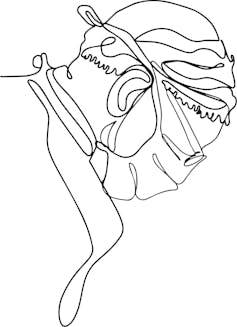
Hillary Kaell, Concordia University
Julian Menezes dons a gown, gloves and face shield and steps into a patient’s room. Then he sits. His job is, simply, to be there — to accompany the sick.
The Royal Victoria Hospital (RVH), where Julian works, has treated over 300 confirmed COVID-19 cases since March. It is one of the busiest designated COVID-19 centres in Montréal, the city weathering by far the most cases in Canada. In all of this, Julian has a key role to play. He is the only spiritual care worker in the hospital’s “hot” zone, where patients with COVID-19 are treated.

Spiritual care workers — also called chaplains — offer emotional and spiritual support to people of any religion or none. Although more than 10,000 spiritual care workers serve institutions across North America, their role often becomes visible to the media only during crises. In the first coronavirus surge, media outlets from the New York Times to ABC News covered their work. Stories focused on the panic and sorrow of those first weeks, especially for hospital patients in isolation and their families, for whom chaplains now had to act as “proxies” or “surrogates.”
Barriers
As the pandemic wears on, the persistent theme of physical barriers, masks and social distancing has become mundane. This reconfiguring of bodies and space is especially evident in hospitals like the RVH.
Julian, who co-authored this article, recalls the anticipation before the first COVID-19 cases arrived. Hospital staff were unnerved as they tensely waited. Would it be a quick surge? What would caring for COVID-19 patients entail?
The hospital organized “hot zones” in a hurry. Staff had to reorient how they mapped and moved through the space. At the RVH, for example, the internal medicine and surgery wards were transformed into COVID-19 floors, and quickly repopulated with patients from Québec’s seniors’ homes.

Following early directives to limit exposure, only staff performing life-saving care were in contact with COVID-19 patients. However, within days of the first cases arriving on March 12, it became clear that patients needed allied health workers, including those providing spiritual care.
Unlike some other hospitals in Montréal, the RVH had kept its four-person spiritual care team on site. At first, the small team covered COVID-19 floors, but avoided entering infected patients’ rooms — known as hot rooms. Then, on May 4, the hospital heightened the barriers between hot and cold zones: the team had to choose one or the other. After some deliberation, it was decided: Julian would cover the hot zone, while his colleagues worked the cold.
Cold and hot
Cold zones brought some of the first surprises. COVID-19 patients and their families expected that visitors would not be able to enter the hot zone. But patients in cold zones, admitted to the hospital for other health reasons, were shocked to learn they would also be cut off from their loved ones. On March 16, the hospital visiting policy had changed. Adult patients were now denied visitors, unless they were dying.
Erecting barriers to limit viral exposure came at a huge emotional cost. As chaplains in hard-hit areas of the United States have noted, the already pervasive fear of dying alone has intensified during the pandemic.
In the hot zones, some patients, especially elderly ones, are too infirm to interact. Others welcome Julian’s visits. That’s when there are other barriers to consider, since he dons protective equipment every time he enters a room. Faces are obfuscated and touch interrupted.
“Those interactions,” Julian explains, “help us mitigate our exposure to pain, suffering and death.… There is a barrier now so I’m not able to be with that person during this moment in the same way.” Being in the hot zone, Julian has become more aware that permeable boundaries — literal and emotional — are what make it possible to accompany people through such experiences. It is much more taxing to be near, observing, but unable to touch or be touched.
Supporting staff
Most media coverage has focused on chaplains’ work with patients and their families, but as the pandemic continued, their support for hospital staff has been vital too. In the days before RVH’s first COVID-19 patients arrived, staff worried most about possibly transmitting the virus to their families. Now other challenges have become apparent.

In the hot zone, nurses who had previously been on surgical wards with a handful of deaths a year, see several patients die each day. They tell Julian they feel powerless, and not only because there is no treatment for COVID-19. Like Julian, they are unable to provide the type of care that nourishes them; they cannot really get to know patients from behind their protective gear or provide reassurance through their touch.
Normally, doctors and nurses rarely stay with patients as they die. That has also changed, now that families are no longer at bedsides. Recently, Julian was present while an ICU nurse held the phone to a patient’s ear so his wife and young children could say goodbye from the hallway outside his room. His wife then asked the nurse to caress his head, in their familiar way, as he died. When it was over, the nurse came out to sit with Julian and the grieving widow. She had participated in ways that, she later confided to Julian, were beyond what she could imagine. There was no curtain to draw or door to close, no barrier to shield her from the grief.
“Being present at a death and witnessing something very intimate is familiar” to chaplains, says Julian. Now his job, in part, is to help other hospital staff acknowledge — and try to accept — what they are being exposed to emotionally.
Exposure
As COVID-19-related hospitalizations trend downwards, we are entering a new phase in the pandemic. Though hospital staff, including its spiritual care team, brace for a possible second surge, for a moment there is some breathing room. And with it, comes space to reflect.
From the hot zone at the heart of Canada’s COVID-19 outbreak, Julian says, “It makes you question, what is it like to live? To die? Is death the worst outcome? Everyone is exposed to these questions in a general way in the hospital. These are people who decided to work with people no one else wants to see. The ill and dying are, in a sense, quarantined already and kept away.”
But even within the hospital, Julian notes, many workers find ways to escape seeing death. “There is this weird juxtaposition in the hot zone where we are all gowned in hazmat suits and protected, and at the same time exposed much more than before to that level of intimacy, of grief.”
That is perhaps the point of entry, the question that guides further reflection: to what has this virus exposed us?
Julian Menezes of McGill University Health Centre co-authored this article. He is a spiritual care professional.![]()
Hillary Kaell, Associate Professor of Religion, Concordia University
This article is republished from The Conversation under a Creative Commons license. Read the original article.


